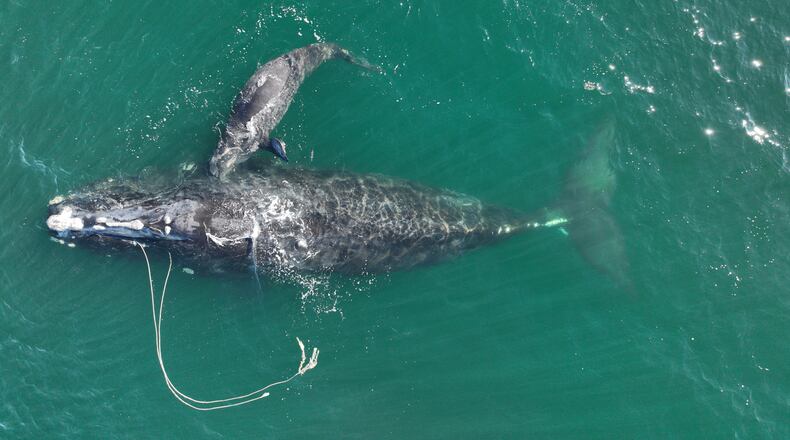The calving season for North Atlantic right whales — one of the most endangered large species on Earth — got off to a promising start late last year.
Each fall, females journey south to the waters off Georgia, the Carolinas and Florida to give birth and nurse their young. The first mother-calf pair of the season showed up 10 days before Thanksgiving off the coast of South Carolina. Weeks later, surveyors saw another pair. Then another and another.
By New Years Eve, 11 pairs had been spotted along the southeast Atlantic coast. After several dismal years with few calves, Clay George said he felt hopeful.
“We were starting to feel pretty optimistic about things, since January is always the peak month for calving,” said George, a wildlife biologist with the Georgia Department of Natural Resources.
But as the calendar turned to 2022, his optimism slowly faded. Since Jan. 1, only four more new calves have been found. Now, with the season effectively over, George said it appears the bumper crop of young whales the species desperately needed did not materialize.
“If we don’t do something quickly, the species could be functionally extinct in a few decades,” he said.
Warming oceans and shifting currents
The North Atlantic right whale, Latin name Eubalaena glacialis, is one of three species of right whales. The docile and somewhat lumbering mammals were coveted for their oil and received their name from whalers who called them the “right” whales to hunt.
By the end of the 19th century, right whales, which can grow to 52 feet in length, had been hunted to the brink of extinction. Today, there are likely fewer than 350 North Atlantic right whales left on the planet, down from 481 in 2011.
Whaling is no longer a threat. But of the key factors contributing to the shrinking population, experts say there is a common dominator: humans.
The leading causes of whale injuries and deaths are fishing rope entanglements and collisions with vessels, George said. Since 2017, 34 of the animals have been found dead along the coasts of the U.S. and Canada, with boat strikes or fishing equipment blamed in most cases.
At the same time, calving rates have also declined. During the first decade of the 2000s, the animals averaged about 24 new calves per year. But since 2010, just 12 have been spotted on average each year.
Credit: Photo by EcoHealth Alliance, NOAA Permit #932-1905
Credit: Photo by EcoHealth Alliance, NOAA Permit #932-1905
In both the deaths and declining birth rates, scientists suspect climate change is playing a major role.
The giant whales rely mainly on tiny crustaceans, barely the size of a grain of rice, for food. But as human activity pumps greenhouse gases into the atmosphere, the oceans warm, changing the distribution of their food supply, according to Erin Meyer-Gutbrod, an assistant professor in the School of the Earth, Ocean and Environment at the University of South Carolina.
To find food, the whales are now traveling beyond their traditional feeding grounds to the waters off the coast of Canada, Meyer-Gutbrod said. She said environmental protections have begun to catch up to the whales’ movements, but it did not happen fast enough in some areas to keep the animals safe from boats and fishing gear.
“Unfortunately, we didn’t anticipate that the right whales would change where they were feeding, so when the whales started going to new places, there weren’t policies in place to protect them,” she said. “This triggered an increase in human-caused deaths.”
The whales’ search for food is also affecting calving. Forced to travel greater distances for less nourishment, females are burning more energy and as a result, struggling to pack on the blubber they need to give birth.
All of this, Meyer-Gutbrod said, has left the whales in a dire situation.
“An endangered population that is experiencing an increase in mortality and a decline in reproduction is at serious risk,” she said.
How humans might help
Though the risk of extinction is real, experts say there are reasons for hope.
After a right whale calf was hit and killed by a boat near Florida last year, there were no other documented cases of whales injured or killed off the coast of Georgia or other states this winter.
There is also a program underway to enlist fishermen in Georgia and other coastal states to test ropeless fishing gear. The systems allow fishermen to deploy traps without leaving lines or buoys in the water, except when retrieving them. The traps can be modified to catch different kinds of fish.
Credit: Sustainable Seas Technology
Credit: Sustainable Seas Technology
After starting a pilot in 2020 with a small group of black sea bass pot fishermen, the program, led by a nonprofit called Sustainable Seas Technology and its founder, Kim Sawicki, was granted a second exempted fishing permit earlier this year. The permit allows a small group of fishermen to use ropeless gear to catch fish between Nov. 15 and April 30 in the waters off Georgia, the Carolinas and Florida that were previously off limits to protect migrating right whales. Sawicki is also applying for another permit to allow ropeless fishing the rest of the year, she said.
Though the black sea bass pot fishery is comprised of only a few fishermen, Sawicki thinks the gear could be modified to be used by larger fisheries in the North Atlantic, which pose a greater threat to the whales.
“We want to share everything we’re learning with all of the different fisheries ... to show that fishing and whales can co-exist in nature and not do any harm to each other,” she said.
Charlie Phillips is a veteran of the fishing, seafood and restaurant business in McIntosh County, along the Georgia coast. His boats have used the gear, and he said he is encouraged by how the testing has gone so far.
“Ropeless gear might be a win-win for the whales and the fishermen,” he said. “The fishermen can go back to work where the fish are in the wintertime and the whales are still protected. We don’t get many win-wins anymore.”
As right whale deaths rise, calving slows
Estimated North Atlantic right whale population in 2011: 481
Estimated North Atlantic right whale population today: Fewer than 350
Average number of new calves spotted per year from 2001 to 2010: 24
Average number of new calves spotted per year from 2011 to 2022: 12
Source: The National Oceanic and Atmospheric Administration and the North Atlantic Right Whale Consortium
About the Author
Keep Reading
The Latest
Featured





